Kitchen Projects #006: Florentines
Team Crunchy or Team Chewy?
Hello!
Welcome to another edition of Kitchen Projects, a recipe development and cooking journal by me, Nicola Lamb. I’m a pastry chef and recipe developer and bakery consultant based in London.
Thank you so much for subscribing - I’m so excited to share this space with you. Part toolkit and part love-letter to food, Kitchen Projects is all about giving you a behind the scenes look of recipe development and building.
This week, I’ve got a festive deep dive for you. Perfect for gifts and generally just eating on the sofa, get ready for FLORENTINES.
If you’re enjoying this then I’d love it if you shared with your friends:
Love,
Nicola
Florentines - chewing it over
Every year, around the same time I first hear the opening chimes of “All I Want For Christmas”, I start to think about florentines.
I’m very particular about them. If you’re not familiar, florentines are caramelised piles of nuts and (if you like) fruit, usually dipped in chocolate. Made well, they look like bejewelled piles of treasure – a rubied cranberry glinting among the gold. They have all the charm of Christmas and, with their ability to turn a cup of tea into something festive and glamorous, they feel quite fancy.
But, despite my love for them, until this year I’d never bothered making them.
And, here’s why: florentines are a pain. I mean that literally – most of them should be sold with a dental appointment. Of all florentines I’ve tried, most completely miss the mark and – in their dreaded way – stick to your teeth like superglue. This, I’m afraid, I cannot bear. There's nothing sadder than picking caramel out of your teeth for hours, praying that it doesn’t dislodge something.
It wasn't until I tried the Thomas Fudge florentines that I felt I was finally in safe hands. Soft, chewy and hardly leaving a trace (other than the emotional one – they do make you very happy), these were my new holy grail.
I’ve spent my life yearning after supermarket biscuits. As a child, I wanted them to sate my burgeoning sugar addiction. As an adult, I want them for their nostalgic comfort. And, as a pastry chef, I want them for their painstakingly perfected formulas.
So in 2020, I’ve decided to finally take on this project and I call this: MISSION FLORENTINE. Welcome!
Shall we do this? Here’s a florentine-festive playlist to get you in the mood
Your florentine, your choice
So, before we continue with all the science-y findings behind the florentines, it’s worth mentioning now that there are a few different sorts.
First, you’ve got a choice between lacy and nutty. Lacy florentines contain flour – they’re more like a traditional biscuit. The latter forgo the flour completely. I prefer my florentines to be (gasp) gluten-free and filled with nuts. I won't be covering lacy florentines in this newsletter.
Your next choice is Team Crunchy or Team Chewy. A crunchy florentine should have a satisfying shatter, yield easily and leave no sticky trace. A chewy florentine should be gooey, soft and again, leave quietly when asked.
Next up is contents: almond is the traditional choice but you can mix this up – pumpkin seeds or pistachios can look very festive, while sesame seeds can add some real magic. I’ve seen nut-free versions made with feuilletine or cornflakes. You also get to decide here if you want to include dried fruit or mixed peel. I personally love coconut flakes.
The final choice is chocolate. In my eyes you’ve got three choices: dark, a not-so-sweet milk, or nothing – just leave them plain. I’m not usually judgemental when it comes to chocolate but I think white chocolate is pretty much out of the running for these (too sweet). My preference is dark chocolate for crunchy and milk chocolate for chewy
I’m going to talk you through making a chewy and also a crunchy florentine. The crunchy one is quite easy to achieve but the chewy one takes a little bit more effort and attention to detail – totally worth it though.
General florentine lessons to live by
One of the keys to getting a successful florentine is nailing the ratio between caramel and filling. You want just enough of the golden stuff to bind the nuts. Anything extra will spurt, burn and spread too much in the oven.
Let’s be honest, dried fruit is absolutely disgusting if you put it in the oven without the protection of dough. Raisins especially tend to expand like little air balloons as they burn before falling back down into tiny, rock hard, teeth-breaking nuggets of flavourless doom. We’ll go through how to avoid this
Florentine tests: The table
In order to make my perfect florentines, I had to try a few combinations of baking methods, sugar temps, sugar types and a few other variables. I’ll walk you through it step by step, but here’s the table I used below to keep notes:
The good, the bad, and the crunchy
I started this florentine journey with a read of Felicity Cloake’s very thorough article on them. The key to chewy florentines, I hoped, was by limiting the cooking time.
Simple enough, I thought. I decided not to divert too much from the classic method and dove right in, starting with the syrup.
I based the syrup on an almond decor I’d been shown at one of my first patisserie jobs: into a saucepan went a mixture of honey, light brown sugar and cream. Once bubbling, I folded in almonds, a little salt, raisins and coconut flakes.
Temp wise, I put my oven on 160c – the aforementioned Guardian article (and Mary Berry) both suggested 180c. That seemed too hot for me, so I erred on the side of caution, preferring a more gentle and longer bake, if necessary.
I dropped piles of the mixture on the tray (as neatly as I could) before putting them into the oven. Knowing that by 10ish minutes the mixture would be fully cooked, I was hoping to take the mixture out at the 7 min mark –at this point, I hoped – it would be golden but still with a little gooey give in the middle.
Alas, at 7 mins the florentines were nowhere near golden and the raisins were unsalvageable. Oh well, I thought. I baked them until golden (12 mins) and nudged them back into a neat shape whilst still warm. Once cooled, I was very happy with their crunch – the combination of cream, brown sugar and honey gave a brilliantly crisp snap. The fruit, however, was bringing me down. WAY DOWN.
I examined the Thomas Fudge florentines, picking off raisins and tasting them. There’s no way these had ever seen an oven – they were still juicy and soft. Given how tremendously sticky the florentines are when warm, I see no reason that the fruit cannot be added afterwards. For my next batch, I tested this out. The fruit adheres beautifully to the florentines although you do need to be a bit careful – the florentines are bloody hot, so proceeding with some caution is a must.
My perfect crunchy florentine? Done.
Next up: soft and Chewy
My personal dream florentine is a soft and chewy, chocolate heavy mouthful. I’ve been thinking about how to recreate this texture and I think the answer is to forgo the oven. And that’s because the key to florentines is the sugar and how you deal with it.
Sugar temps is one of those things I prefer not to think about unless completely necessary – and today, my friends, it is necessary. Strap yourselves in, we’re about to do a bit of theory:
Sugar, when heated, radically changes. Sugar + direct heat = caramel.
However, adding water to the equation enables sugar to go through various stages before caramelisation. As you heat sugar syrups, it begins to transform: as water evaporates, the syrup reaches varying degrees of water concentration. By the time your sugar solution turns into caramel, the water concentration of your solution is 0% and you are left with 100% sugar.
It’s these varying levels of water concentration that offer different properties to confections/candies.
The lower the temp of the syrup, the softer your final product will be (higher water to sugar ratio) whilst the higher the temp, the harder your final product will be (low water to sugar ratio, will also be caramel flavoured)
From my knowledge of caramel making, the sugar temperature to aim for is between 115c – 118c for a softer caramel. Ideally 116c! Anything above this your sugar will begin to transform. That’s why when you bake florentines in a 160c oven, it’s impossible to get something chewy. It significantly overshoots the 115c-118c range.
From this understanding of sugar temps, I realised that to get a chewy florentine I may not need to turn my oven on. A chewy florentine was going to be all about the digital thermometer.
However, without the oven, how was I going to get the caramel flavour and beautiful golden colour? I cooked up a batch of the light brown sugar + honey + cream mixture and brought it to 116c before folding my nuts and fruit in. Given that this mixture doesn’t even see the oven, there’s no reason that the dried fruit can’t join the party from the outset. The result? Gorgeously chewy but hideously anemic.
In order to achieve the golden colour, I was going to have to switch things up a bit. Instead of light brown sugar, I heated caster sugar until it was a light golden caramel (no temp needed, just used my eyes – you can decide how dark you like your caramel!) then whisked in the cream and honey, which sputtered and bubbled. From here I heated it over a gentle flame, digital probe in hand, until it reached 116c. I stirred this into my fruit/nut mix, allowed to cool slightly and then divided into little clumps. The result? ALMOST PERFECT. I had the colour down, but without the oven time, the nuts do need some advance toasting for the flavour to be properly elevated.
I whipped up another batch, this time with the nuts pre-toasted and the result? Brilliant. Dreams do come true. In terms of flavour, you don’t get quite the same level of burnt honey flavour, either, but I think that’s a deal worth making. You can always go darker on the initial caramel to satisfy that part.
To mould or not to mould, that is the question
First, let’s cover crunchy
When it comes to baking the florentines, you’ve got two options: freeform or with a little help from a tin.
Freeform florentines are made by plopping heaps of the mixture onto baking paper – you can weigh them (20g is my preference) or just eyeball it with a spoon. It’s best to keep them as lumpy as possible to mitigate some of the imminent spreading. Florentines tend to spread in a fairly unpredictable and uneven manner and the only workaround, without using a mould, is utilising a silicone spatula and nudge the florentines back into shape whilst still warm. High tech? No. Effective? Very.
If you have silicone cupcake cases or moulds then you will soon also be the owner of extremely neat and tidy florentines. They look beautiful but cook slightly differently – as the honey/cream/sugar mixture is limited in its path of travel, you’ll get a denser and neater final product. It’s extremely crunchy as the nuts are essentially being deep fried in the syrup. I only have a metal tray and I cannot, in good faith, recommend using it for the baked florentines. They look beautiful but are impossible to get out of the tin.
Now, onto the soft.
The soft florentines can be shaped in a few ways. Firstly, by hand. If you are going to shape by hand, it’s important you let the mixture cool a little as hot sugar is… well, bloody hot. Once cooled slightly, you can scoop the mixture into your hands (it’ll be a bit sticky but not too bad) and form into neat, flat rounds.
Alternatively, you can spoon your mixture into cupcake tins (silicone or metal) and press the florentines into shape. This will give you a very neat finish.
A note on the dangers of caramel
I hope you never have to find this out, but caramel burns are among my least favourite.Although this recipe is unlikely to cause much danger, let me just talk to you quickly about caramel burns and what to do: If you do get a little bit of the caramel syrup on your skin then the best thing to do is immediately and briefly soak the hand in a little warm water - this will allow the caramel to warm slightly and can be removed gently. After this, proceed treating the area as normal - run the area under cold water for at least 10 minutes and then clean and cover the area.
It may seem counterintuitive to use warm water at first but it will mean you can remove the caramel safely. If you put your hand under cold water, the caramel will set immediately and fuse to your skin. If you pull the caramel off, it may take some skin with it.
Dipping methods
Do you really want to temper your chocolate? If so, good for you. I think that tempering chocolate is a noble pursuit and should always be congratulated.
To temper your chocolate, scale the amount of chocolate you want to use and then divide it by 5. Melt 4/5 of it either in the microwave or gently in a bain-marie. Once melted, stir in the remaining 1/5th and stir it in. Agitate the mixture well until it becomes thicker and shiny. If you have a digital probe, you’re looking for about 28c for dark chocolate and 27c for milk chocolate.
If you can’t be bothered to temper then that’s okay too. I think it’s more than fine to stick the tray in the freezer to hurry things along. Sometimes, in life, it’s nice not to be too precious about things.
Florentines with the fancy pattern on the bottom will be made by placing the chocolate onto special plastic textured chocolate sheets (purchase them if you like) to set, leaving the pattern imprinted. You can mimic this by allowing the chocolate to set slightly and then wiggling a fork over. This can look nice but it is quite annoying to do.
This isn’t practical for most of us, so here a a few other florentine dipping options below:
Medium effort: Classic simple
Medium-high effort: Spread/dip and wiggle
Almost zero effort: Press florentine into chocolate
Zero effort: The half dip
Alright let’s make them!
Equipment
Digital Thermometer (for Chewy)
Crunchy Florentines
50g light brown sugar
50g honey
50g double cream
3g salt - if you like crunchy bits throughout, stir salt into the nuts. Otherwise just mix into the honey/cream/sugar
90g flaked almonds
15g pistachios
40g coconut flakes (not desiccated!)*
15-20g dried fruit, chopped to the size you like (I use cranberries)
Around 150g chocolate, melted, for dipping (dark for crunchy I think!)
Florentines offer ripe opportunities for substitutions. You can use any mix of nuts you like here. Just try and keep the approximate weights the same. You can also add in mixed candied peels, citrus zests, cornflakes, oats and really, anything you like, so long as you keep the approximate ratios the same.
Method
Pre-heat oven to 160c
Warm light brown sugar, honey and cream together. Bring to boil then remove from heat
Mix into the nuts - NOT the fruit
Place generous teaspoons onto a baking tray lined with paper - leave space for the florentines to spread
Bake for 10-12 mins until golden. Check after 8 mins in case your oven is aggressive. But mine are usually perfect at 12 mins
Nudge, using a silicone spatula, the florentines back into a decent shape. If you try to do this with anything other than a silicone spatula then it’ll be annoyingly sticky
Now place the dried fruit on the hot florentines - it will stick!
Leave to cool completely before dipping
Chewy Florentines
50g caster sugar
50g honey
50g double cream
3g salt - if you like crunchy bits throughout, stir salt into the nuts. Otherwise just mix into the honey/cream/sugar
90g flaked almonds - toasted until golden, around 15 mins in a 165c oven
15g pistachios
40g coconut flakes (not desiccated!) - also toasted until golden, 8 mins in 165c oven
15-20g dried fruit, chopped to the size you like (I use cranberries)
Around 150g milk chocolate, melted, for dipping (dark for crunchy I think!)
Please note the same suggestions from the crunchy florentines
Method
Place the sugar in a saucepan and place over a medium heat. You can stir it as it melts. Take it to a light caramel. You can go darker, but know that it will go dark quite fast as soon as it goes golden
One you’ve achieved the colour you like, stir in the double cream and honey. It’ll splutter and bubble
Now get your digital thermometer! Over a low heat, warm until the mixture reaches 116c. If you go above this, the harder the florentines will set
Mix into the toasted nuts and fruit and stir
Allow to cool slightly before dividing - place generous teaspoons onto a baking tray and then smooth with your hands into neat piles. You can put a little oil on your hands if it is really sticky. Alternatively, press into cupcake moulds
Leave to cool completely before dipping


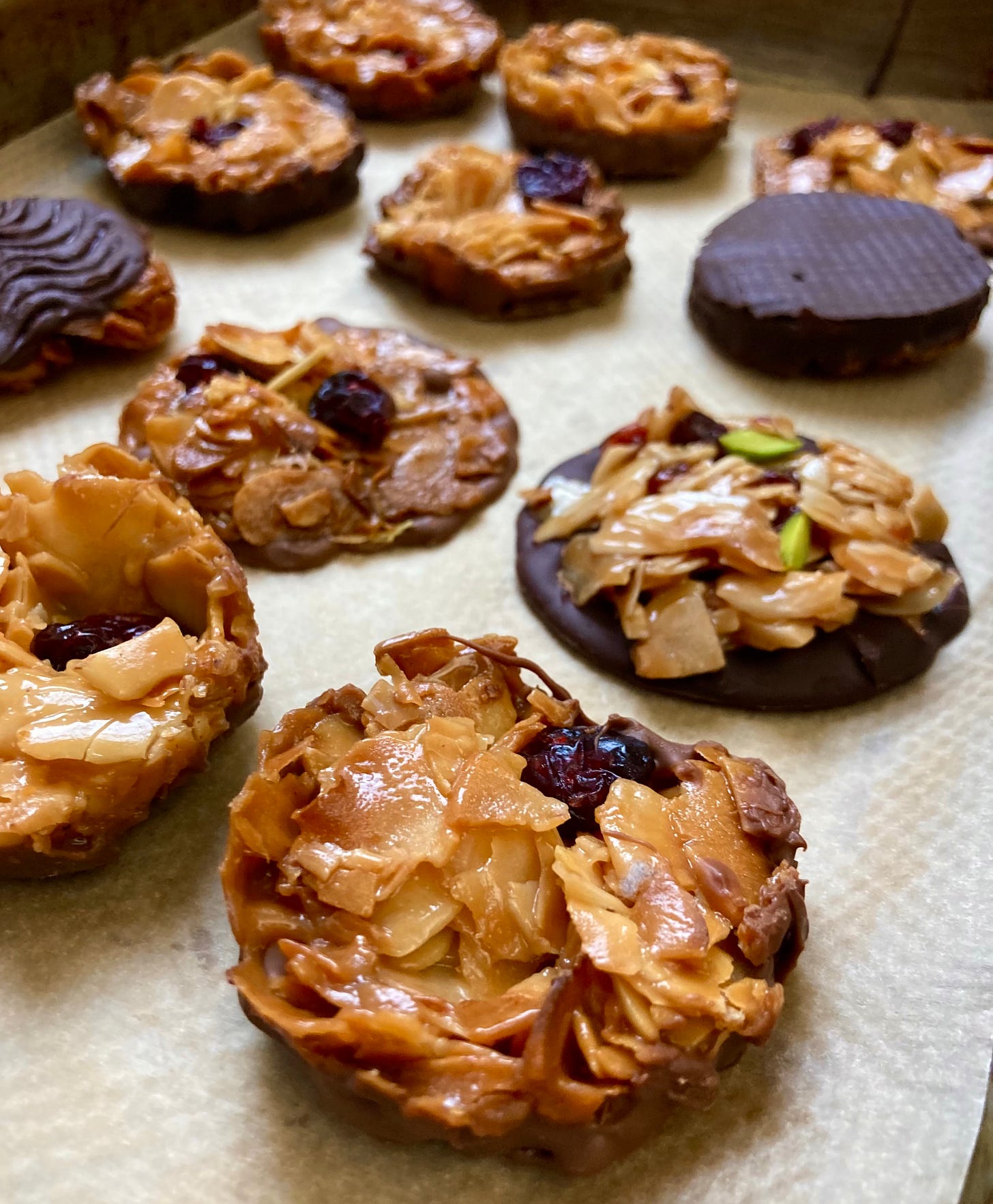

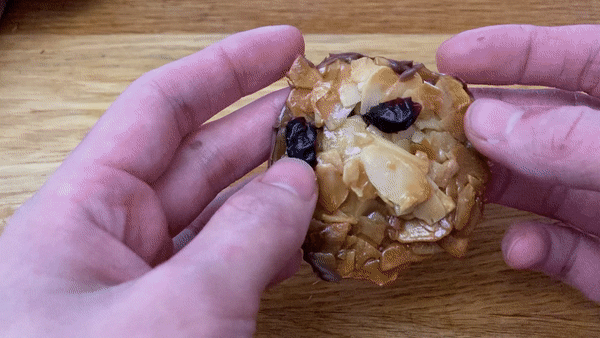
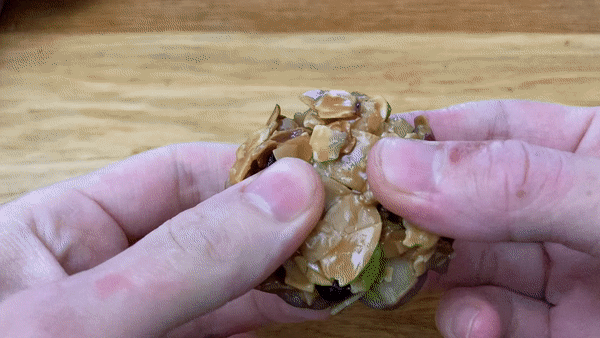
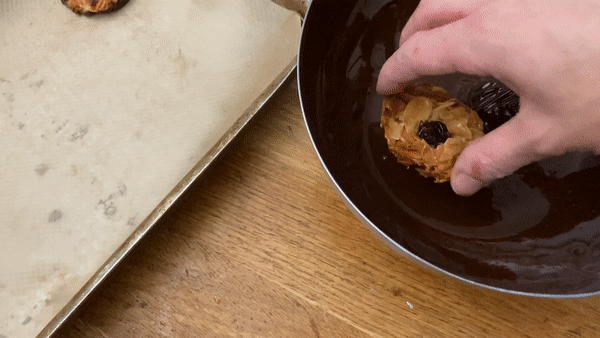
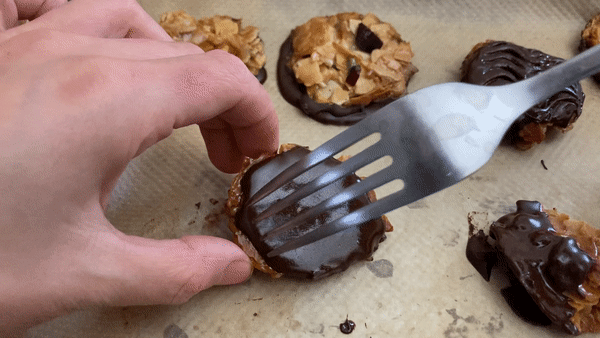
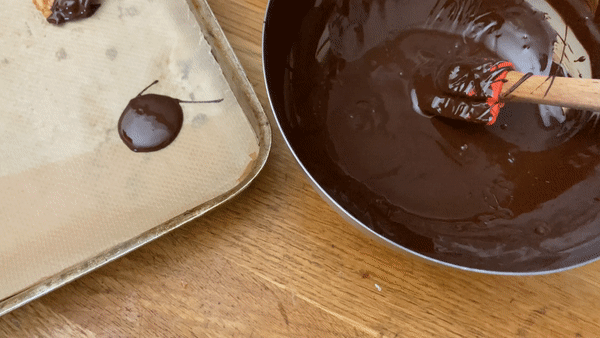
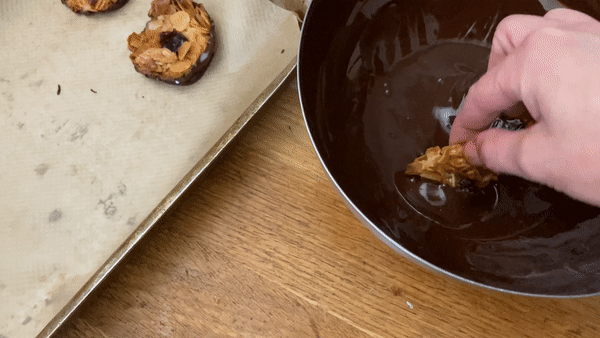
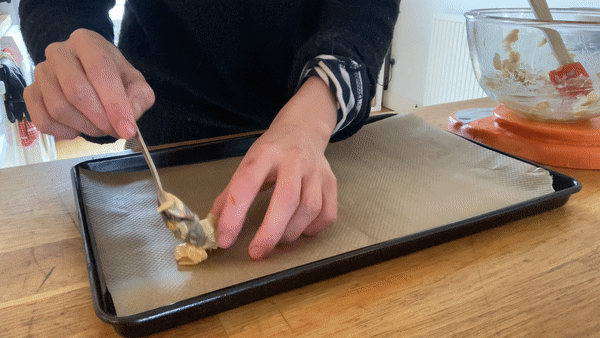
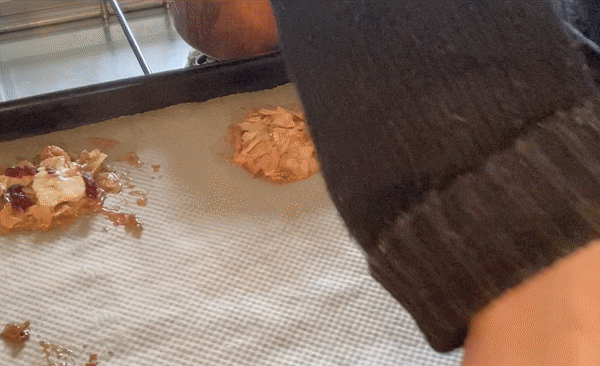
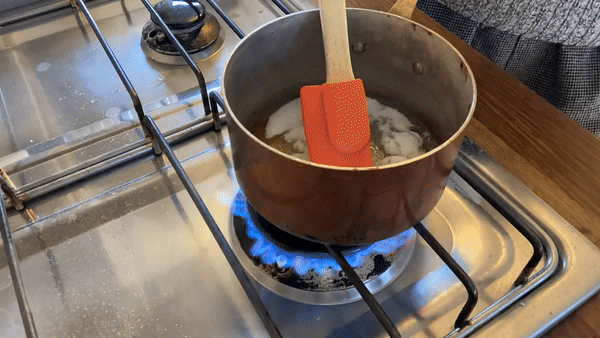
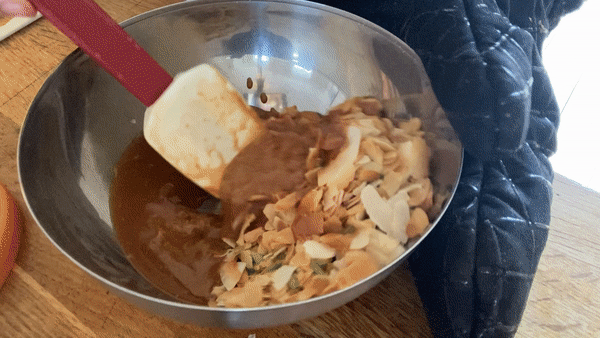
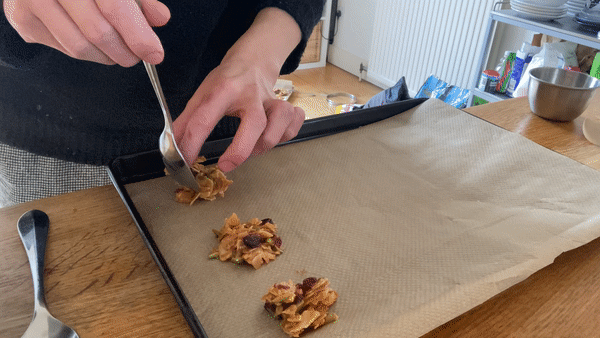
Hi Nicola, I tried both recipes and they were delicious! However, my “crunchy” florentines were quite chewy. Crunchy once frozen, but I’d love to have them harden at cool room temp. I live in a dry environment, so humidity likely isn’t the issue. I’ve been doing some research into other recipes for florentines of this style and they often use butter, less heavy cream, and do cook to a specific sugar syrup temp. One theory I have is that the water in heavy cream + the brown sugar caused the over-soft texture, and perhaps that I didn’t bring the syrup to a full boil. I would love to hear your thoughts! I want to try again.
I wonder if the raisins can be soaked beforehand in order to bake along with the mixture for crunchy florentines 🤔